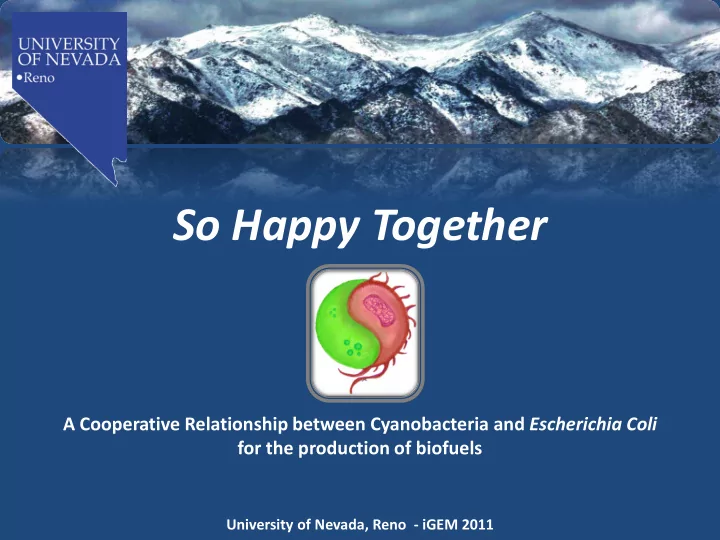

So Happy Together A Cooperative Relationship between Cyanobacteria and Escherichia Coli for the production of biofuels University of Nevada, Reno - iGEM 2011
Introducing iGEM Team Nevada 2011 20 Undergraduates in Biochemisty, Biology, Biotechnology and Engineering With Advisers Dr. Howard Dr. Shintani Dr. Ellison
Concept from Crisis • Petroleum is a disappearing resource • As resources diminish, costs increase
Biofuels are the Solution
But at What Cost? • Ethanol increases demand for corn which increase corn prices • Ethanol profits shrink due to an increase in production cost • Fewer crops are planted and farmland prices increase • Large biomass requirements for production in corn
Developing an Alternative Biofuel • While we have manufactured several different types of biofuels, the cost in comparison to petroleum makes it an expensive alternative • An inexpensive and self sustaining biofuel needs to be developed
Developing an Alternative Biofuel • E. Coli has the potential to produce large quantities of fatty acids but 30-40% of its production cost goes into supplying growth media How do we reduce this cost? • Cyanobacteria has the unique ability to sustain itself without the cost requirements of E. coli • Cyanobacteria produces less than half the amount of biofuel produced by E. coli How do we solve these problems?
Our Project Cyanobacteria E. coli
Cyanobacteria • Cyanobacteria are a phylum of bacteria that obtain their energy through photosynthesis Cyanobacteria under the • Cyanobacteria Synechocystis PCC 6803 is an microscope excellent research model, because its entire genome has been sequenced and it is easily transformed • Team Utah 2010 graciously supplied us with the cyanobacteria tool kit that allowed us to develop new operons Electron micrograph of Synechocystis sp 6803
Developing an Auxotroph ADP glucose pyrophosphorylase (AGP) • Invertase (INV) • Glycogen Glucose Facilitator Transporter (GLF) •
Invertase Development Total Cyanobacteria Genome • ADP glucose • petBD • Inverstase ( INV ) pyrophosphorylase ( AGP ) is a a promoter that has strong converts ADP-glucose naturally occurring gene in expression in log and into glucose and fructose Cyanobacteria that converts stationary phase ADP-glucose to glycogen
Glucose Facilitative Transporter Development Total Cyanobacteria Genome Thiamine monophosphate pyrophosphrylase (ThiE) • Thiamine monophosphate • Glucose Facilitator pyrophosphorylase ( ThiE ) Transporter ( GLF ) a naturally occurring gene in a transporter gene that Cyanobacteria that produces moves glucose and fructose thiamine (Vitamin B1) outside of the cell
Synechocystis Accomplishments • Chloramphenical resistance cassette needed to be debugged before amplification pSB1C3 was used as a template for amplification of the coding region for Chloramphenical resistance • All Synechocystis construct parts are amplified and ready for Gibson
Our Project Synechocystis E. coli
Ethanol Production • Pyruvate Decarboxylase • Alcohol Dehydrogenase • σ 70 promoter ( PDC ) converts pyruvate to ( ADH ) converts Constitutive promoter acetaldehyde ( Zymomonas acetaldehyde into ethanol that is not affected by mobilis) glucose
Ethanol Production • Pyruvate Decarboxylase Assay • Alcohol Dehydrogenase Assay
Our Project Synechocystis E. coli
Fatty Acid Production • Acyl-ACP is intercepted by Bay Laurel Thioesterase ( Umbellularia Acyl-ACP californica ) • Bay Laurel Thioesterase will turn Acyl-Co A in to C12 and C14 fatty acid derivatives.
Fatty Acid Production Colorimetric assay results of free fatty acid production versus negative controls
Fatty Acid Production • Gas chromatography results of Bay Laurel Thioesterase controlled by the σ 70 constitutive promoter
Co-Cultivation So Happy Together!
Co-Cultivation : Media 10-ß E. coli cells grown in BG-11 with glucose or BG-11, glucose, and NH4Cl. 2 1.8 1.6 LB 1.4 OD (600 nm) 1.2 1 BG-11 + 50 mM glucose 0.8 0.6 0.4 0.2 BG-11 + 50 mM glucose + 1.0 mg/mL NH4Cl 0 0 5 10 15 20 25 30 Time (hours) • Confirmed auxotrophies of E. coli
Co-Cultivation: Media Average growth (n=3) of Iq cells grown in BG-11, 0.20% casaminos, and decreasing concentrations of glucose 2 LB 1.8 1.6 BG-11 1.4 OD (600 nm) 1.2 BG-11 + .20% casaminos 1 0.8 BG-11 + .20% casaminos + 10 mM glucose 0.6 BG-11 + .20% casaminos + 2.5 mM 0.4 glucose 0.2 BG-11 + .20% casaminos + 1.0 mM 0 glucose 0 5 10 15 20 25 30 Time (hours) • No significant drop in effectiveness of glucose at 2.5 mM
Co-Cultivation: Apparatus • Apparatus must run for several days at a time • Stop contamination from external environment • Prevent cross- contamination as E. coli travels through dialysis tubing
Co-Cultivation: Apparatus Testing of cross-contamination between chambers (test done in BG-11 + 0.2% casamino acids + 50 mM glucose) 1.2 1 OD (600 nm) 0.8 Uninoculated 0.6 Chamber E. coli 0.4 Chamber 0.2 0 0 21 29 41 48 Time (hours)
Contributions to iGEM • Solved sequencing errors in pSB1C3 • Apparatus used to co-cultivate different forms of bacteria • Developed an ethanol generator • Developed a medium chain fatty acid generator
Future Applications • Production of high value compounds in engineered E. coli • Self sustaining possibilities for any fermentation system
Human Practices Sam and Megan presenting at Student performance at UNR iGEM Concert the Rotary Club • Thank you Elaine Marguerite teaching children about synthetic biology
Checklist for Commemoration Submitted 8 parts to registry Demonstrated functionality of two parts Developed apparatus to co-culture E. coli and Synechocystis Collaborated with Utah State Collaborated with MIT in debugging pSB1C3 • Thank you Austin Che and the Knight Lab at MIT Developed a method for creating auxotrophies in Synechocystis for environmental control.
Thank You
Recommend
More recommend